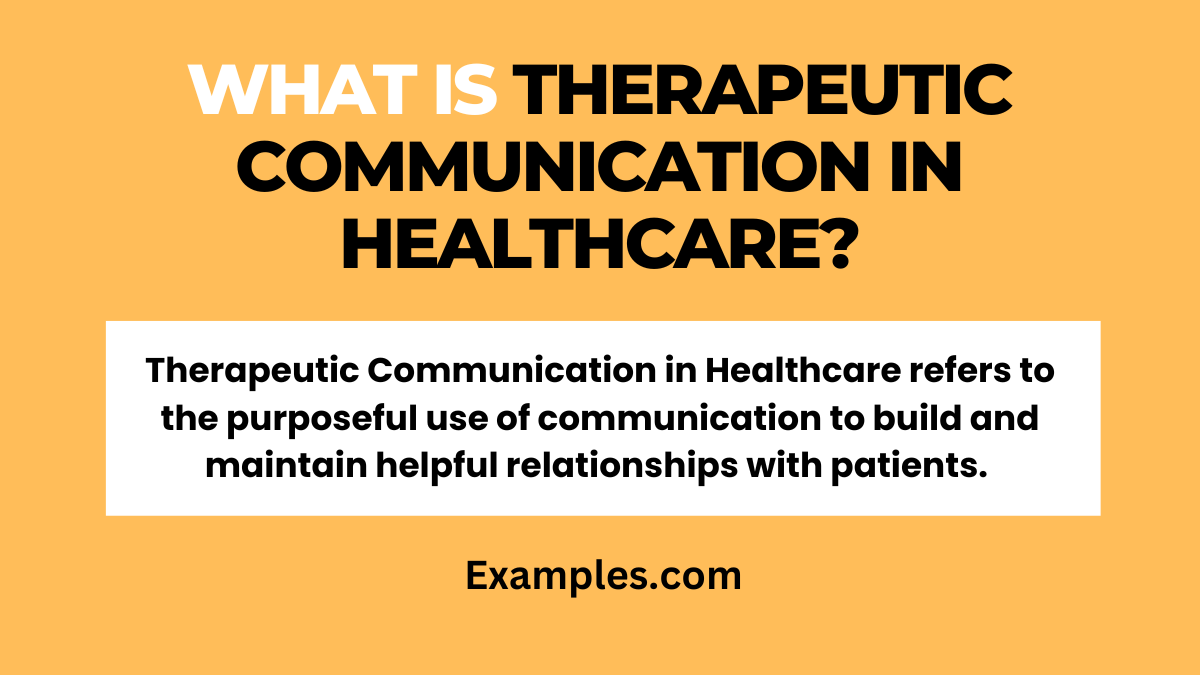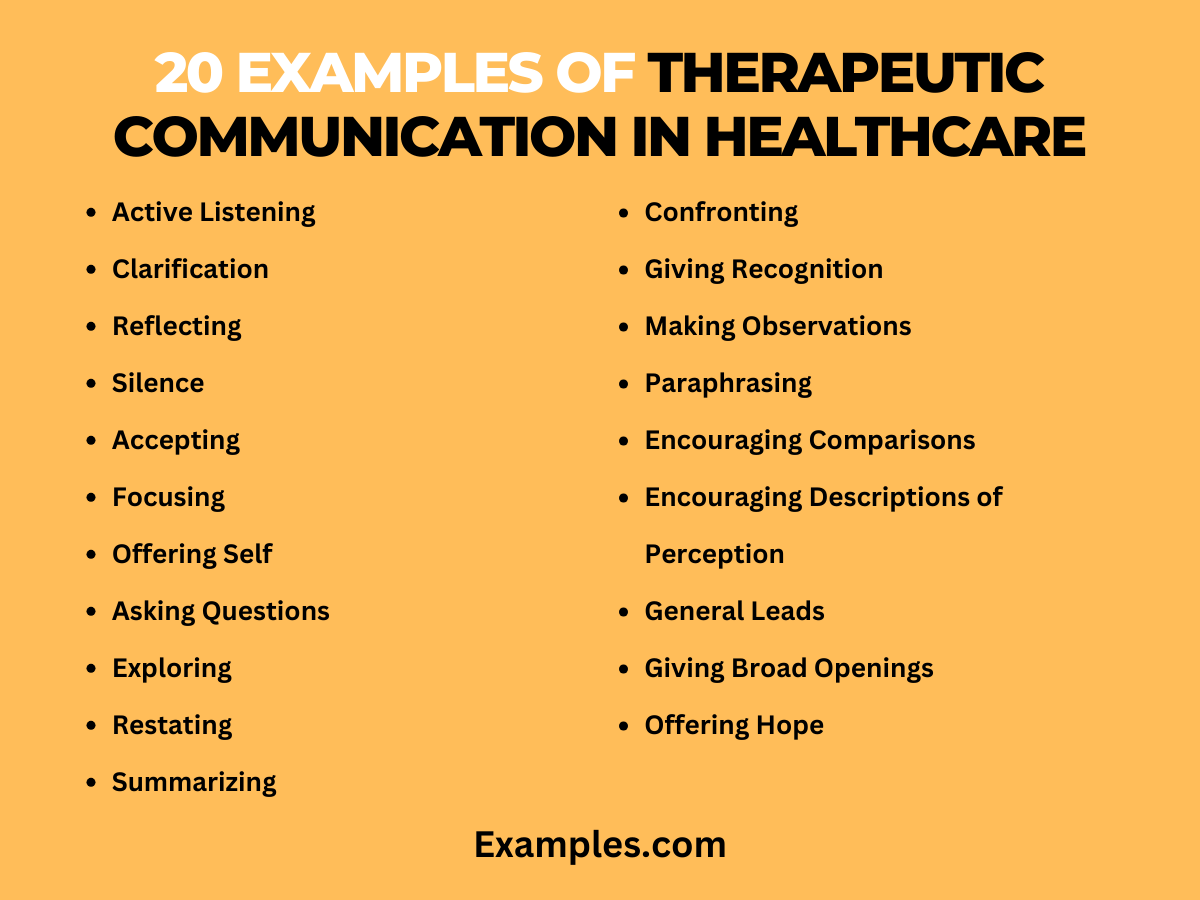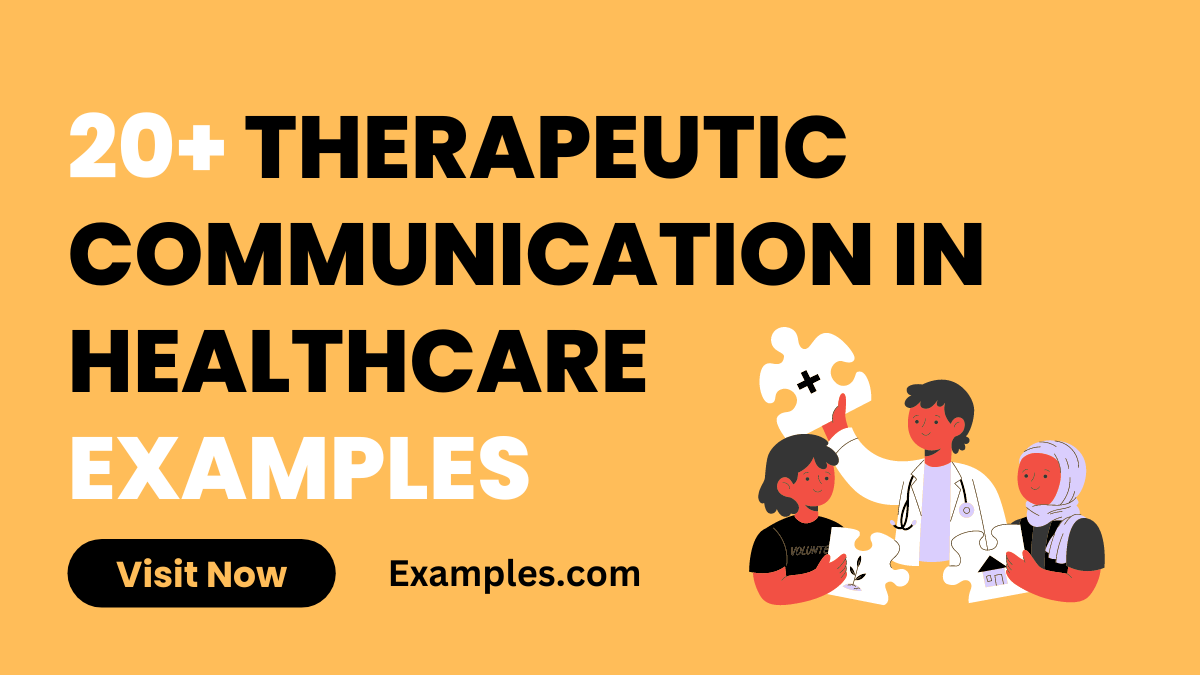19+ Therapeutic Communication in Healthcare Examples
Therapeutic Communication in Healthcare is a vital skill set that significantly impacts patient outcomes. This comprehensive guide delves into effective strategies and provides practical oral communication examples to enhance interactions in a healthcare setting. From building rapport to conveying empathy, learn how to communicate in a manner that supports and empowers patients. Whether you’re a seasoned professional or new to the field, these insights will refine your communication skills and improve your healthcare practice.
What is Therapeutic Communication in Healthcare?

Therapeutic Communication in Healthcare refers to the purposeful use of communication to build and maintain helpful relationships with patients. It involves actively listening, showing empathy, and responding in a way that promotes patient well-being and understanding. This type of communication is not just about exchanging information; it’s about creating a supportive environment where patients feel heard, respected, and cared for. It’s a key element in providing effective healthcare and ensuring positive patient experiences.
20 Examples of Therapeutic Communication in Healthcare
Therapeutic communication in healthcare is essential for fostering a positive patient-clinician relationship. This guide offers 20 unique and distinct examples of therapeutic communication, each accompanied by a brief explanation of its implementation in a healthcare setting. These examples demonstrate how healthcare professionals can use specific communication techniques to support, empathize, and effectively interact with patients. Incorporating these practices can lead to improved patient satisfaction and outcomes.

- Active Listening: Show your patient that you are fully engaged in the conversation by nodding and saying “I understand.” This technique ensures the patient feels heard and valued.
- Clarification: Ask questions like, “Can you explain more about that?” to ensure you fully understand the patient’s concerns, eliminating misunderstandings.
- Reflecting: Repeat back what the patient has said, for instance, “It sounds like you’re feeling anxious about the surgery,” to show understanding and empathy.
- Silence: Allow moments of silence after the patient speaks, giving them space to add more thoughts or feelings, showing respect for their pace in communication.
- Accepting: Say “I acknowledge your feelings,” to validate their emotions, promoting a safe and trusting environment.
- Focusing: Guide the conversation back to the main issue if it drifts by saying, “Let’s go back to discussing your current treatment plan.”
- Offering Self: Make yourself available, “I’m here to talk if you need,” to build trust and rapport.
- Asking Questions: Use open-ended questions like, “How do you feel about your treatment options?” to encourage detailed responses.
- Exploring: Delve deeper into a patient’s statement with, “Tell me more about your experience with the medication.”
- Restating: Repeat a key phrase the patient said, “You mentioned feeling tired often,” to show attention to their concerns.
- Summarizing: Wrap up a conversation by summarizing key points, “So, you’re concerned about the side effects of this medicine.”
- Confronting: Address inconsistencies in a patient’s account gently, “Earlier, you mentioned feeling better, but now you seem worried.”
- Giving Recognition: Acknowledge changes or efforts, “I’ve noticed you’ve been following your diet plan closely.”
- Making Observations: Comment on non-verbal cues, “You seem a bit tense today, is everything okay?”
- Paraphrasing: Rephrase the patient’s words for clarity, “So, you’re saying that the pain increases at night?”
- Encouraging Comparisons: Ask the patient to compare experiences, “How does this treatment compare to your previous one?”
- Encouraging Descriptions of Perception: Invite the patient to describe their perception of the situation, “How do you see your progress so far?”
- General Leads: Use general statements to encourage further conversation, “Go on…”
- Giving Broad Openings: Allow the patient to choose the topic, “What would you like to discuss today?”
- Offering Hope: Provide reassurance, “Many patients see improvement with this treatment.”
Importance of Therapeutic Communication in Healthcare
Therapeutic communication in healthcare is pivotal in establishing a healing environment. It bridges the gap between healthcare providers and patients, ensuring that the care provided is not just clinically effective but also emotionally supportive. By facilitating open dialogue, therapeutic communication allows for a deeper understanding of patients’ needs, fears, and expectations. This communication style plays a crucial role in patient recovery by promoting trust, reducing misunderstandings, and ensuring that patients feel valued and understood. Incorporating these practices leads to improved patient adherence to treatment plans and overall better healthcare outcomes.
- Validating Patient Feelings: Saying, “It’s understandable to feel worried about your treatment,” acknowledges and validates patient emotions.
- Using Humor Appropriately: Lightening the mood with a gentle joke, when appropriate, can ease patient anxiety and build rapport.
- Providing Reassurance: Comforting patients with words like, “We’re doing everything we can for your treatment,” offers emotional support.
- Displaying Personal Interest: Asking about a patient’s hobbies or family shows that you care about them as a person, not just a patient.
- Offering Encouragement: Saying, “You’re making great progress,” can boost a patient’s morale and motivation.
- Expressing Concern: Demonstrating concern with phrases like, “I’m worried about how this is affecting you,” shows empathy.
- Avoiding Assumptions: Asking open-ended questions rather than making assumptions about a patient’s feelings or experiences.
- Respecting Privacy: Acknowledging a patient’s need for privacy with statements like, “Let me know if you need some time alone.”
- Being Patient: Allowing patients to express themselves at their own pace without rushing them.
- Affirming Patient’s Strengths: Highlighting a patient’s strengths, “Your positivity is really admirable,” encourages resilience.
Therapeutic Communication Techniques for Healthcare Professionals
Therapeutic communication techniques for healthcare professionals are essential tools for enhancing patient care. These techniques not only facilitate better understanding and empathy but also foster an environment where patients feel comfortable and respected. Implementing these strategies can lead to more effective patient interactions, increased trust, and improved health outcomes. For healthcare professionals, mastering these techniques is crucial for developing strong patient relationships and delivering compassionate, patient-centered care.
- Mirroring Patient’s Language: Using similar phrases or words as the patient to create a sense of familiarity and comfort.
- Providing Information Clearly: Ensuring that patients understand their condition and treatment by using clear, straightforward language.
- Using Reflective Questions: Encouraging deeper conversation with questions like, “How does that make you feel?”
- Acknowledging Patient’s Expertise: Recognizing a patient’s knowledge about their own body and experiences.
- Using Metaphors: Simplifying complex medical information with metaphors to make it more understandable.
- Non-Verbal Attentiveness: Showing attentiveness through eye contact, nodding, and appropriate facial expressions.
- Checking Understanding: Regularly checking if the patient understands the information by asking, “Does that make sense?”
- Tailoring Communication Style: Adapting your communication style to suit different types of patients and their individual needs.
- Practicing Patience: Taking the time to listen without interrupting, showing respect for the patient’s perspective.
- Encouraging Patient Participation: Inviting patients to ask questions and be active participants in their healthcare.
What are the Advantages of Using Therapeutic Communication in Healthcare?
Therapeutic communication in healthcare is not just a practice; it’s a cornerstone for patient-centered care. This communication style, steeped in empathy and understanding, offers numerous advantages that transform the healthcare experience.
Firstly, it fosters a trustful relationship between healthcare providers and patients. When patients feel heard and understood, they are more likely to open up about their concerns, leading to more accurate diagnoses and effective treatment plans. This active listening in Therapeutic Communication is not just about hearing the words but understanding the emotions and concerns behind them.
Moreover, therapeutic communication can significantly reduce patient anxiety and stress. By employing techniques like offering hope and presenting reality, healthcare professionals can alleviate fears and provide a sense of reassurance. This aspect is particularly vital in managing chronic conditions, where emotional support is as crucial as medical treatment.
Additionally, therapeutic communication enhances patient engagement and compliance. When patients are actively involved in their care process, they are more likely to adhere to treatment regimens and make informed decisions about their health. Techniques like asking questions in Therapeutic Communication and encouraging descriptions of perception empower patients, making them active participants in their healthcare journey.
Finally, this approach contributes to a more holistic care experience. By addressing the emotional and psychological aspects of a patient’s health, alongside the physical symptoms, therapeutic communication ensures a comprehensive approach to healthcare. This is especially important in fields like Therapeutic Communication in mental health nursing and Therapeutic Communication for Cancer Patients, where emotional well-being is a critical component of care.
In summary, therapeutic communication in healthcare is a key driver for improved patient outcomes, enhanced patient-provider relationships, and a more empathetic, comprehensive approach to health and wellness.
What are the Key Principles of Effective Therapeutic Communication in Healthcare?
Effective therapeutic communication in healthcare revolves around several key principles that ensure meaningful and productive interactions between healthcare providers and patients.
The first principle is empathy, which involves understanding and sharing the feelings of another. This principle is crucial in establishing a connection with patients. Techniques like reflecting in Therapeutic Communication and making observations help convey empathy, making patients feel valued and understood.
Respect is another fundamental principle. It involves acknowledging the patient’s dignity, beliefs, and values. By employing accepting in Therapeutic Communication and giving recognition, healthcare professionals can show respect for their patients’ perspectives and experiences.
Clarity and simplicity in communication are essential to avoid misunderstandings. This can be achieved through paraphrasing in Therapeutic Communication and using general leads to guide the conversation in a clear, straightforward manner.
Another key principle is active listening. This means not only hearing what the patient says but also paying attention to nonverbal cues and reading between the lines. Techniques like silence in Therapeutic Communication and restating can facilitate deeper understanding.
Nonjudgmental attitude is vital in therapeutic communication. It involves creating a safe space where patients can share their thoughts and feelings without fear of criticism. Employing confronting in Therapeutic Communication in a gentle manner and encouraging comparisons can help in understanding patient perspectives without passing judgment.
Lastly, consistency and honesty in communication build trust. This includes being truthful about diagnoses and treatment options and consistently offering support. Presenting reality and voicing doubt in a sensitive way are part of this honest dialogue.
In conclusion, the principles of effective therapeutic communication in healthcare revolve around empathy, respect, clarity, active listening, a nonjudgmental attitude, and honesty. These principles are the bedrock of building a therapeutic relationship that promotes healing, understanding, and patient satisfaction.



